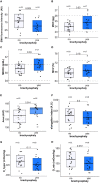Differences in selected blood parameters between brachycephalic and non-brachycephalic dogs
- PMID: 37649563
- PMCID: PMC10464621
- DOI: 10.3389/fvets.2023.1166032
Differences in selected blood parameters between brachycephalic and non-brachycephalic dogs
Abstract
Introduction: Cranial and upper-airway anatomy of short-nosed, flat-faced brachycephalic dogs predisposes them to brachycephalic obstructive airway syndrome (BOAS). Periodic apnoea increased inspiratory resistance, and an inability to thermoregulate effectively are characteristic of BOAS, but internationally accepted objective markers of BOAS severity are missing. The objective of this study was to compare the selected blood parameters between non-brachycephalic (NC) and brachycephalic (BC) dogs, exploring the possibility of developing a blood test for BOAS severity grading in the future.
Methods: We evaluated blood biochemistry, complete blood cell counts, red blood cell (RBC) indices, reticulocyte counts, a blood-born marker of intermittent hypoxia (glutathione, NO production), RBC hydration, deformability, and blood markers of metabolic changes and stress between BC (n = 18) and NC (meso- and dolichocephalic, n = 22) dogs.
Results: Reticulocyte counts and the abundance of middle-fluorescence immature reticulocytes were significantly (p < 0.05) higher in BC dogs compared to NC dogs. BC dogs had significantly more NO-derived NO/NO in plasma than NC dogs. RBCs of BC dogs were shedding significantly more membrane, as follows from the intensity of eosin maleimide staining, and had a significantly higher mean corpuscular hemoglobin concentration than NC dogs. Intracellular reduced glutathione content in RBCs of BC dogs was significantly lower, while plasma lactate was significantly higher in BC dogs compared to NC dogs. Plasma cholesterol and triglycerides were significantly lower, and cortisol was significantly higher in BC dogs compared to NC dogs. Eosinophil counts were significantly lower and the neutrophil-to-lymphocyte ratio was higher in BC dogs compared to NC dogs.
Discussion: Taken together, our findings suggest that the brachycephalic phenotype in dogs is associated with alterations at the level of blood cells and, systemically, with oxidation and metabolic changes. The parameters identified within this study should be further investigated for their potential as objective indicators for BOAS.
Keywords: blood markers; brachycephalic obstructive airway syndrome; brachycephaly; dog; hypoxia; red blood cells; stress.
Copyright © 2023 Kämpf, Fenk, Van Cromvoirt, Bogdanov, Hartnack, Stirn, Hofmann-Lehmann, Reichler and Bogdanova.
Conflict of interest statement
The authors declare that the research was conducted in the absence of any commercial or financial relationships that could be construed as a potential conflict of interest.
Figures







Similar articles
-
Anatomical, functional, and blood-born predictors of severity of brachycephalic obstructive airway syndrome severity in French Bulldogs.Front Vet Sci. 2025 Jan 9;11:1486440. doi: 10.3389/fvets.2024.1486440. eCollection 2024. Front Vet Sci. 2025. PMID: 39850586 Free PMC article.
-
Thrombocytosis in brachycephalic dogs with brachycephalic obstructive airway syndrome.Vet Med (Praha). 2023 Feb 15;68(2):57-61. doi: 10.17221/23/2021-VETMED. eCollection 2023 Feb. Vet Med (Praha). 2023. PMID: 38332764 Free PMC article.
-
Salivary cortisol measurements in brachycephalic dog breeds as part of a standardized stress test.Front Vet Sci. 2024 Jul 31;11:1351225. doi: 10.3389/fvets.2024.1351225. eCollection 2024. Front Vet Sci. 2024. PMID: 39144074 Free PMC article.
-
Strategies for the management and prevention of conformation-related respiratory disorders in brachycephalic dogs.Vet Med (Auckl). 2015 Jun 4;6:219-232. doi: 10.2147/VMRR.S60475. eCollection 2015. Vet Med (Auckl). 2015. PMID: 30101109 Free PMC article. Review.
-
Consequences and Management of Canine Brachycephaly in Veterinary Practice: Perspectives from Australian Veterinarians and Veterinary Specialists.Animals (Basel). 2018 Dec 21;9(1):3. doi: 10.3390/ani9010003. Animals (Basel). 2018. PMID: 30577619 Free PMC article. Review.
Cited by
-
Evaluation of a caudal midline glossectomy on tongue volume and upper airway cross-sectional areas in brachycephalic dogs: a cadaveric study.Front Vet Sci. 2025 Aug 4;12:1607711. doi: 10.3389/fvets.2025.1607711. eCollection 2025. Front Vet Sci. 2025. PMID: 40831897 Free PMC article.
-
Anatomical, functional, and blood-born predictors of severity of brachycephalic obstructive airway syndrome severity in French Bulldogs.Front Vet Sci. 2025 Jan 9;11:1486440. doi: 10.3389/fvets.2024.1486440. eCollection 2024. Front Vet Sci. 2025. PMID: 39850586 Free PMC article.
References
-
- Club A. K. Lab Most Popular Breed for 30th Straight Year; Frenchie Jumps to No. 2. (2021). Available online at: https://www.akc.org/expert-advice/dog-breeds/labrador-retriever-popular-... (accessed July 27, 2023).
-
- The The American Kennel Club I . Most Popular Dog Breeds. (2022). Available online at: https://www.akc.org/most-popular-breeds/
-
- Lorenz K. Studies in Animal and Human Behaviour Volume II. 2, 115–195. Cambridge, MA: Harvard University Press. (1971). 10.4159/harvard.9780674430426 - DOI
-
- Ashley S . The Best Low-Maintenance Dogs for People with Super-Hectic Lives. PureWow.com. (2022). Available online at: https://www.purewow.com/family/low-maintenance-dog-breeds (accessed July 27, 2023).
LinkOut - more resources
Full Text Sources

